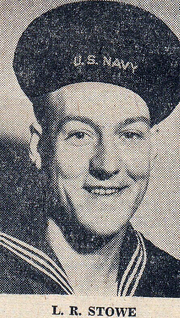Sioux City Sailors Home After Action Off Africa
His hands still bearing the blisters he received while helping removed crippled and sick men from the American transport Tasker H. Bliss as it was sinking off the coast of French Morocco weeks ago, L.R. Stowe, pharmacist’s mate third class, has arrived in Sioux City to visit his parents and his wife.
Stowe served aboard the Bliss with another Sioux Cityan, Joe Pumputes and with Jack Morrow, former South Sioux City high school star athlete. All are home on leave now.
Ran To Help
“When I first found the ship was sinking, I instinctively rushed to the side to jump over,” says Stowe. “But the water looked as if it had too much oil on it, so I started for the other side to see how it was there. Suddenly, I remembered about all the men in the sick bay. As a pharmacist’s mate, I was supposed to help them.
“I ran to see what I could do. There were plenty of men who had become ill and others who had been injured. We found we had to lower then over the side, so I climbed down a ladder and stood there, waiting for the patients to be handed down. When I got hold of one, I’d pass him to someone on a boat or liferaft.
We got all the men off.”
Ashore the Americans found that facilities for medical aid and surgery already had been set up by the army medical corps. The Sioux Cityan saw operations performed on tables in what formerly had been a Moroccan wine shop.
Had Wrong Idea
When things settled down a bit, Stowe had a change to look around. He found the Arabs dressed “in nothing more than rags.” Once in a while an Arab would show up wearing a life preserver he had fished out of the sea.
“The Arabs seemed to have the wrong idea about life preservers,” says Stowe. “They’d put them on and wait for enemy planes to come over, strafing. Then they’d lie on the ground, laughing while bullets spattered around them.”
Stowe’s father, Ed Stowe, resides at 1404 Virginia Street. His mother and wife live at 710 Pearl Street.
Marvin B. Shay
“The destroyer I helped man knifed into Casablanca Harbor full speed with all guns blazing,” said Coxswain Marvin B. Shay, captain of No. 1 gun on the first American warship to storm the French stronghold.
The young sailor, who is visiting his parents, Mr. and Mrs. B.L. Shay, 4205 Tyler Street, emerged unscratched from days and nights of fighting on an African Bay so full of death it was nicknamed Torpedo Junction.
“Not everyone was so lucky,” young Shay said. “Germans manning the shore batteries sure took a blasting. They started the fight but we finished it. The harbor itself became pretty messy when our fleet had to batter French ships that tried to escape.”
“Those French sailors were real seaman and all our boys admired their courage. Poor fellows! Like us they were only obeying orders. That was before Darlan switched to our side.”
French Surrender
The French fleet surrendered one dawn as Shay’s destroyer made a run for the harbor preparing to fire. The shore batteries were silent and some American troops had landed.
“When the French gave up, our boys poured off the transports by the thousands. It all went like clockwork. From beginning to end the invasion was a perfect piece of military timing.
“Funny about those Frenchmen,” Coxswain Shay observed. “When we boarded their ships after the surrender, they felt as friendly toward us as we did toward them. Here we were trading smiles with men we had been trading fire with the day before.”
Before the fighting was stopped, Shay saw two torpedoes miss his ship by a few feet. Later, when the main sea fight was over, the young sailor saw three empty transports go down.
Got the Submarines?
German submarines must have slipped into the harbor too late to get our men,” he said, “but the way our depth bombs roiled the bay, I’ll bet our ships got the submarines.”
During the height of one engagements Shay’s destroyer dropped a charge so close it lifted its own stern out of the water.
Excitement at sea is not new to Coxswain Shay. He shipped first 1936. Three years later he was honorable discharged from the navy because of an injury suffered when his vessel, the mine-sweeper Swallow, sank under him in Alaskan waters.
He reenlisted last July.
Source: The Sioux City Journal, December 14, 1942 (photo included)
![]()

